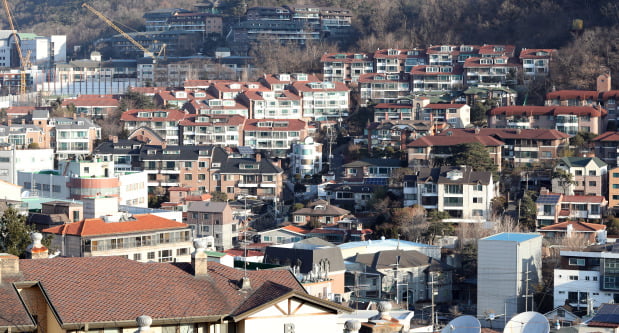
Photo = Yonhap News
Public redevelopment, which the government introduced with the aim of expanding housing supply in Seoul, is more likely to cruise. It is expected that more than 30 sites will be selected as candidates only through the first and second competitions, and public redevelopment projects can be promoted. The government estimated that more than 30,000 households could be supplied if the relevant districts meet the agreement rate, etc. and conduct the project. Controversy over the adequacy of candidate site selection is also rising, such as the removal of the maintenance decommissioning area, which is relatively old.
28 districts including Hannam 1, final review for public redevelopment
![[단독] Seoul Public Redevelopment, Hannam 1, Seongbuk 1, etc.](https://i0.wp.com/img.hankyung.com/photo/202102/01.25508983.1.jpg?w=560&ssl=1)
According to the maintenance industry and each autonomous district on the 24th, a total of 28 districts were finally recommended to Seoul as candidates for the second public redevelopment. It is equivalent to 60% of the 47 application areas.
Seongbuk-gu and Yeongdeungpo-gu, where old low-rise residential areas are concentrated, each had the highest number of candidates for recommendation. In Seongbuk-gu, Seongbuk 1, Jangwi 8, Jangwi 9, Seongbuk 4 District, in Yeongdeungpo-gu, Shingil 1, Singilbamdongsan, Shingil 16, Dorim-dong, etc. were listed on the list of candidates.
One of the Hannam District 1 in Yongsan-gu was recommended. In Mapo-gu, Ahyeon 1, Daeheung District 5, in Seongdong-gu, Geumho 23 Hawangsimni District, etc. were named as candidate sites. In the Gangnam area, reconstruction of detached houses was promoted, and in Gangdong-gu, which was destroyed, Cheonho 1, Godeok 2-1. It turned out that Godeok 2-2 area was finally judged.
The final selection of 28 zones will be decided through the’Ministry of Land and Seoul Joint Public Redevelopment Demonstration Project Candidate Selection Committee’ at the end of next month. The maintenance industry evaluated the areas as exceeding the 9 division ridge for the final candidate site selection. The recommendation of a candidate site means that it has met the requirements for designating a maintenance area, which is considered the biggest gateway for promoting redevelopment projects. A government official said, “The selection committee will additionally review the appropriateness of the business plan,” and “there are already meeting the requirements of the city plan of Seoul, and there is consensus on the necessity of project promotion, so many positively reviewed. It is becoming,” he said.
Public redevelopment is a reorganization project in which the Korea Land and Housing Corporation (LH) and Seoul Housing and Urban Corporation (SH) provide incentives such as floor area ratio as a condition to participate in the implementation, and instead accept donations such as rental housing. Even if it is selected as a candidate site, it is necessary to obtain the consent of at least two-thirds of the residents in order for the project to proceed. The government selected eight existing maintenance areas as the primary project sites last month, and plans to disclose the new business sites in the second time in March. The second candidate site is for new areas that have been lifted from the maintenance area or have not yet been designated.
“The old age is higher, but it falls off”…
In the process of selecting the second candidate, there were voices raising questions about the selection method as a dropout zone that exceeded the market’s expectations came out. This time, 19 areas were eliminated, including Shinwol 7-dong 1 district in Yangcheon-gu, Daerim 3 district in Yeongdeungpo-gu, and Seongbuk district 5 in Seongbuk-gu. Excluding some of the historical and cultural preservation zones, most of them failed to meet the’Residential Maintenance Index’ score, which is the standard for retirement.
In particular, many of the deteriorated areas of housing, which are severely deteriorated, have slipped out of the screening process, leading to back words about the screening criteria. Among the areas that were eliminated this time, five areas that were designated as maintenance areas in the past were lifted: Jangwi 11, Jangwi 12, Seongbuk 5, Samseon 3, and Sungin 1, Jongno-gu. Seongbuk District 5, which received a preliminary feasibility test from LH in October last year, has 84% of buildings and 44% of gross floor area.
In the rejected areas, it is argued that the standards of the Seoul City’s 2025 Urban and Residential Environment Improvement Basic Plan created in 2015 are too strict. Through the 2025 City Plan, Seoul has greatly strengthened the standards for deterioration by introducing new gross floor area standards and residential maintenance indexes. In fact, there has been no case of a new zone designation after such revision.
Mo Hyun-sook, chairman of the Seongbuk District 5 Redevelopment Promotion Committee, said, “If the current standards are close to 84% of buildings, there is no way to develop Seongbuk District 5. It is also against the equity that the region is recommended.” Seongbuk District 1, whose age is lower than that of Seongbuk District 5, was listed on the list of candidate sites this time. This is because it was designated as a planned maintenance area in the past, and the 2010 city plan was applied instead of the 2025 city plan. A government official said, “There is no problem in the screening process because the standards in accordance with the current laws and principles were applied,” but said, “For those who have dropped out, they will be able to re-challenge once the standards are eased.” The Seoul Metropolitan Government is considering easing the redevelopment zone designation requirements in the ‘2030 Seoul Urban and Residential Environment Improvement Basic Plan (Housing Redevelopment Section)’ scheduled at the end of the year.
Reporter Lee Yoo-jung [email protected]
